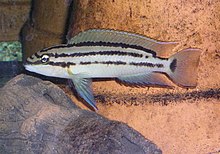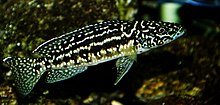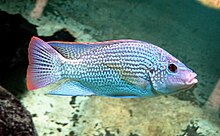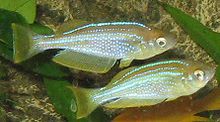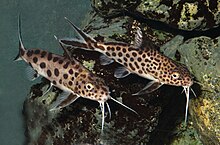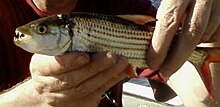Flora and fauna of Lake Tanganyika
The Tanganjikasee is one of the largest lakes in Africa (3 ° 20 'and 8 ° 48' south and 29 ° 5 'to 31 ° 15' to the east) and the second deepest and sixth largest sea earth. The lake, whose water surface is 782 meters above sea level , has an average depth of 570 m, the maximum depth is 1,470 m (in the northern part). The catchment area of Lake Tanganyika is 231,000 km². Its main tributaries are the Ruzizi , Kalambo and Malagarasi . It drains into the Congo via the Lukuga .
The lake's water is unusually alkaline with a pH of 8.6 to 9.5 . It has a total hardness of 7 to 11 ° dGH, a carbonate hardness of 16 to 19 ° dKH and a conductivity of 570 to 640 μS / cm. Even so, the lake is home to over 310 species of fish, 95% of which are endemic . As in the other large African lakes, the cichlids make up the largest part of the fish fauna.
Habitats
Although Lake Tanganyika is 1470 meters deep, higher life and with it the habitat of the fish ends at a depth of around 100 meters in the northern part of the lake and at a depth of 200 meters in the southern part, as the deeper water layers are almost without oxygen (anaerobic) and contain toxic hydrogen sulfide .
Riparian zones

Rocky shore
The most species-rich biotope of Lake Tanganyika is the Felslitoral, often designed as a steep coast without shallow water areas. Higher plants are missing here. Since the water is poor in suspended particles, is very translucent and often has a visibility of over ten meters, the rocks are covered with a growth of algae. The algae form the nutritional basis of the cichlid genus Tropheus and other representatives of the Tropheini tribe . Other genera living there are Altolamprologus , Chalinochromis , Julidochromis , Lepidiolamprologus , Neolamprologus and Telmatochromis , as well as the Tanganyika light-eyed fish ( Lamprichthys tanganicanus ), whiskered catfish and spiny eels . Chalinochromis , Julidochromis , Neolamprologus and Telmatochromis comb through the algae for different small organisms, Altolamprologus , Lepidolamprologus and the spiny eels eat small crustaceans, snails or smaller fish. All cichlids in the Felslitorals, except for the species of the Tropheini tribe, which are mouthbrooders, use the niches, caves and crevices between the rocks as hiding places for their eggs.
Scree banks
The scree littoral consists of flat bank areas, the bottom of which is covered with gravel and scree, mostly stones the size of a fist or football. Here, too, there are no higher water plants and the stones are covered with algae. The spaces between the smaller stones create a greater number of hiding spots than in the Felslitoral. The scree littoral is the habitat of the Eretmodini , also called goby cichlids in German, which feed on the algae and the insect larvae that live in them.
Sandbank
The most species-poor and monotonous shore area of Lake Tanganyika are the flat, sandy shores. While the inhabitants of the stony coasts are territorial , the fish of the sandy shore appear in schools. These are mainly cichlids from the Ectodini tribe , which are relatively colorless in adaptation to their habitat. The most common are gray or whitish tones, sometimes with silvery sides with a bluish or greenish sheen. Dark markings are missing. The fish feed by chewing through the sand. Some small Lamprologus and Neolamprologus species living there use the shells of the large Neothauma freshwater snails as hiding places for their spawn. The sand littoral is also the main distribution area of the few higher plants found in Lake Tanganyika, the direct bank zone is often overgrown with reeds . Ctenochromis horei and the herbivore Limnotilapia dardennii are species of cichlids that mainly inhabit plant populations.
Transition zone
The transition zone from the rock to the sand littoral is characterized by sandy subsoil and piles of rocks, stones and rubble lying in it like islands. As in the sand zone, there are mainly cichlids from the Ectodini tribe ( Aulonocranus dewindti , cyathopharynx and ophthalmotilapia species) as well as Neolamprologus tretocephalus and N. tetracanthus .
Sublittoral
The deeper bank areas between 50 meters and the beginning of the hostile depth below 100 to 200 meters also have their special fauna. Cichlids from the Limnochromini tribe mainly occur here. Gnathochromis permaxillaris from this group has a highly specialized, very flexible mouth with which it sucks up hoppers from the ground. The snail cichlid Lamprologus ornatipinnis and Neolamprologus brevis , spiny catfish of the genus Chrysichthys and the snail-eating whiskered catfish Synodontis multipunctatus are also at home here.
Estuaries
Non-endemic cichlids and carp fish live in the estuaries, especially in Lake Tanganyika . They are often characterized by large stands of plants, a muddy bottom and, especially in the rainy season , cloudy, loamy-brown colored water. Among the here occurring non-endemic cichlids include Astatotilapia burtoni , bluelip haplo the different Oreochromis species, redbreast tilapia and Tylochromis polylepis , as well as endemic species Callochromis macrops , Callochromis pleurospilus , Ctenochromis horei , limnotilapia dardennii and Simochromis diagramma .

Open water
The pelagic of the lake is much poorer in species than the various shorelines. The most common fish there are two types of herring, the Lake Tanganyika sardine ( Limnothrissa miodon ) and Stolothrissa tanganicae . Both occur in huge swarms, are only about 10 cm long and feed on plankton . They are the food source for some ichthyophageous cichlid genera ( Bathybates , Hemibates and Boulengerochromis ), which in turn are eaten by four species of endemic giant bass ( Lates angustifrons , L. mariae , L. microlepis and L. stappersii ). The plankton-eating cichlids of the Cyprichromini tribe also live in the open water near the shore .
plants

The number of aquatic plant species in Lake Tanganyika is small in relation to the size of the lake. The most common aquatic plant is Vallisneria spiralis var. Denserrulata , which forms large meadows in the sand zone on the shore of the lake and in the transition area to the scree and rock zone. It occurs to a depth of four, more rarely up to six meters, grows only five to ten centimeters high in areas with high currents and little protection, and develops leaves that are unusually hard and bent downwards in order to be able to withstand the movement of the waves. In sheltered places it shows its usual growth form, up to 40 cm high. The rough horn leaf ( Ceratophyllum demersum ) is the only aquatic plant that occurs at depths of up to ten meters. It grows unusually compact in Lake Tanganyika, has dense internodes , a hard leaf structure and is heavier than the water. In this way, this fragile plant, which does not develop real roots, prevents it from floating loose on the surface of the water and perishing there exposed to the strong waves. The milfoil ( Myriophyllum spicatum ) often grows between stands of Vallisneria spiralis or the rough horned leaf in the shallow sandy zone, but is more light-sensitive, only occurs at depths of up to three meters and is usually only leafed at the tips of the shoots, while the lower ones in the shade Stem sections are bare. Two species of pondweed, the crested pondweed ( Potamogeton pectinatus ) and P. schweinfurthii, form large underwater meadows in sheltered bays with sandy soils or in the transition zone to the scree zone at depths of one to four meters. They are completely absent in areas with heavy swell. P. schweinfurthii is the largest plant in Lake Tanganyika with a maximum shoot length of 3.5 meters, while P. pectinatus only grows half a meter high. The ground nettle ( Hydrilla verticillata ) forms herbaceous stands in the sand zone at a depth of about one meter and has egg-shaped leaves that differ from the normal, lanceolate leaves. It is only rare in the lake, as are the two mermaid herbs , the great mermaid ( Najas marina ) and Najas horrida . All plants have unusually hard leaves in adaptation to the extreme water chemistry and the strong wave movement near the shore.
Cichlids
The fish fauna of Lake Tanganyika is dominated by cichlids (Cichlidae), all of the African subfamily Pseudocrenilabrinae . Almost all species and the great majority of the genera are endemic , with the Bathybatini , Benthochromini , Boulengerochromini , Cyphotilapiini , Cyprichromini , Ectodini , Eretmodini , Limnochromini , Perissodini and Tropheini also ten endemic tribes and apart from a few species of the genus that live in the Congo Lamprologus , all Lamprologini can only be found in Lake Tanganyika. In Lake Tanganyika there are both mouthbrooders and substrate spawners and cave breeders, including some small Lamprologus and Neolamprologus species that use snail shells. The number of cichlid species in the lake is around 250. This means that Lake Tanganyika has fewer species than the similar Lake Malawi (over 1200 species) and Lake Victoria (400 to 500 species). The cichlid fauna of Lake Tanganyika, however, shows greater variability than that of Lake Malawi and Lake Victoria, which consist almost exclusively of species from the Haplochromini tribe . It is assumed that the cichlid fauna of Lake Tanganyika has evolved from a multiple settlement of the lake by different species of origin.
All the cichlid species in the lake are listed below:
All the cichlid species in the lake are listed below:
Non-cichlids
In addition to the dominant cichlids, around 100 other fish species live in Lake Tanganyika. In contrast to the cichlids, which are 97% endemic, the endemism of the rest of the fish family is much lower and is around 50%. Many of the non-endemic species are only found in the mouths of the rivers flowing into Lake Tanganyika or in the area immediately adjacent to them.

Giant bass
Puffer fish
Spiny eels
Tooth carp
- Lacustricola pumilus
- Tanganyika light-eyed fish ( Lamprichthys tanganicanus )
Catfish
Tetras
|
Carp fish

Ear fish

Pegs
- Lake Tanganyika Sardine ( Limnothrissa miodon )
- Stolothrissa tanganicae
Nile pike
|
Pike
- Polypterus congicus
- Ornate pike ( Polypterus ornatipinnis )
Lungfish
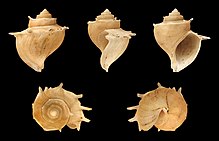

Invertebrates
In addition to the cichlids, snails in Lake Tanganyika have also formed numerous new species from a few immigrated freshwater snails in the course of rapid adaptive radiation . Endemic snail genera are Tanganyicia and Stanleya from the family of crown snails (Thiaridae), as well as Hirthia , Lavigeria and Paramelania from the family Pleuroceridae . The genus Neothauma from the family of marsh lobsters (Viviparidae), whose shells are of such great importance for the small cichlids, shares Lake Tanganyika with Lake Malawi. More in Tanganjikasee living invertebrates are the fresh jellyfish Limnocnida tanganyicae , about ten kinds of swimming crabs (Potamidae), all in the genus Potamonautes , freshwater prawns (Atyidae) palaemonidae (Palaemonidae), two endemic river and pond shells (Unionidae) ( Brazzaea and pseudospatha ) and seven different types of sponges .
Terrestrial vertebrates
Terrestrial vertebrates that are closely tied to the water on the shores of Lake Tanganyika are the Nile crocodile ( Crocodylus niloticus ), the water cobra ( Boulengerina annulata stormsi ) and the African fish eagle ( Haliaeetus vocifer ).
literature
- Ad Konings and Horst-Walter Dieckhoff: Secrets of Lake Tanganyika. Dähne, 1992, ISBN 3-9284-5710-1
- Petru Banaescu: Zoogeography of Fresh Waters . Pp. 1150-1152, AULA, Wiesbaden 1990, ISBN 3-89104-480-1
- Søren Neergaard: Lake Tanganyika cichlids. Kernen Verlag, 1976, ISBN 3-87401-005-8
- DATZ special issue Tanganyika Lake, Verlag Eugen Ulmer, 1998, ISSN 1616-3222
- Damien Delvaux: Development of the Lake Tanganyika Trench. in DATZ special issue Tanganyika Lake
- Jos Snoeks, Mark Hanssens & Erik Verheyen: Diversity of Tanganyika fish . in DATZ special issue Tanganyika Lake
Individual evidence
- ↑ a b Christel Kasselmann : Aquatic Plants. in DATZ special issue Tanganyika Lake
- ↑ Fishbase Species in Lake Tanganyika
- ↑ Konings and Dieckhoff (1992), p. 11.
- ↑ a b c d e f g h Wolfgang Staeck: Communities and living spaces. in DATZ special issue Tanganyika Lake
- ↑ a b Heinz Büscher: Cichlids in snail shells. in DATZ special issue Tanganyika Lake
- ↑ Lukas Rüber: Origin of the Tanganyika cichlids. in DATZ special issue Tanganyika Lake
- ↑ Celine Clabaut, Walter Salzburger, Axel Meyer : Comparative Phylogenetic Analyzes of the Adaptive Radiation of Lake Tanganyika Cichlid Fish: Nuclear Sequences Are Less Homoplasious But Also Less Informative Than Mitochondrial DNA. J Mol Evol (2005) 61: 666-681 doi : 10.1007 / s00239-004-0217-2
- ↑ Luc De Vos and Jos Snoeks: The non-cichlids of the Tanganyika basin. in DATZ special issue Tanganyika Lake
- ↑ Matthias Glaubrecht : The snails of Lake Tanganyika. in Aquaristik Fachmagazin, No. 168 December 2002 / January 2003, Tetra, Berlin, ISSN 1437-4854
- ↑ Petru Banaescu (1990): pp. 1150-1152.
- ↑ Konings and Dieckhoff (1992), p. 15.
- ↑ Konings and Dieckhoff (1992), pp. 13 and 14.





